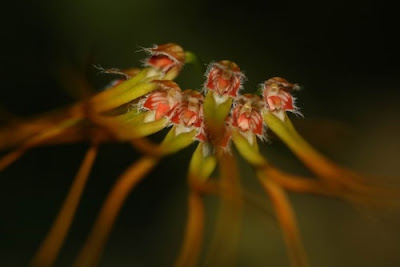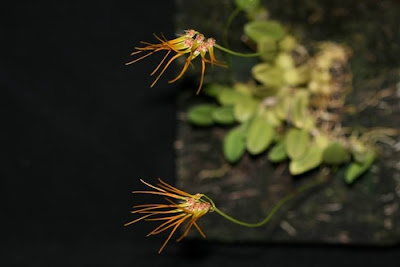Bulbophyllum setaceum is native to Taiwan. This orchid was found in the northern part of the island, where it grew epiphytically, in virgin broadleaf forests on tree trunks an altitude of 1800-2400 m.
Bulbophyllum setaceum, also called as The Bristly Bulbophyllum (refers to the dorsal sepal and petals), Bulbophyllum ciliisepalum, Bulbophyllum taitungianum, is a species of the genus Bulbophyllum. This species was described by T.P. Lin in 1975.
IDENTIFY BULBOPHYLLUM SETACEUM
Bulbophyllum setaceum is native to Taiwan. This orchid was found in the northern part of the island, where it grew epiphytically, in virgin broadleaf forests on tree trunks an altitude of 1800-2400 meters above sea level.
It is a mini-miniature sized, cool to cold growing epiphyte, which can reach the height of 5 cm, with close set to 0.4" (1 cm) between each ovoid to narrowly cylindric, rugose, ribbed, 3-4 cm long and 1.2-2.0 cm wide pseudobulb carrying a single, apical, erect, fleshy, rigid, leathery, elliptic to oblong elliptic, obtuse, retuse, narrowing below into the shortly petiolate, 3-4 cm long and 1.2-2.0 cm wide base leaf.
The Bristly Bulbophyllum blooms in the spring on a basal, erect, green, 5.6 to 6.4" (14 to 16 cm) long, 12 to 16 flowered inflorescence with ovate-lanceolate floral bracts. The flowers are brownish-green, sit on long stalks. Upper sepals are concave, with reddish-brown veins, a short tail on the tip and white villi along the edges. The lateral sepals are yellow-green with a reddish tinge at the base and an orange-brown apex. In length they reach 3.4 cm, narrowing, form long pointed tips. The edges of the lateral sepals at the base are covered with villi, twisted inward and connected to each other except for the elongated apical part. The elliptical pointed petals have five red-brown veins and whitish-yellow villi along the edges. Similar to a tongue, a curved lip is orange-red with green spots at the top.
BULBOPHYLLUM SETACEUM CARE AND CULTURE
Cultural information should only be used as a guide, and should be to be adapted to suit you. Your physical location; where you grow your plants, how much time you have to devote to their care, and many other factors, will need to be taken into account. Only then can you decide on the cultural methods that best suit you and your plants.
Light:
Bulbophyllum setaceum needs a light level of 12000-20000 lux. The light should be filtered or dispersed, and the plants should not be exposed to the direct sunlight of the midday sun. Strong air movement should be ensured all the time.
Temperature:
The average temperature of the summer day is 22-23 ° C, the night 13-14 ° C, and the daily difference is 7-9 ° C. The average temperature of the winter day is 15-17 ° C, the night 5-7 ° C, and the daily difference is 10 ° C.
Humidity:
The Bristly Bulbophyllum needs a humidity level of almost 90% from the end of spring to early autumn, and the rest of the year is 80-85%.
Substrate, growing media and repotting:
Bulbophyllum setaceum are usually grown in very shallow pots or baskets using a loose, quickly drying substrate tightly packed around the roots. For basic components such as fine or medium bark, or chopped woody fern fiber, various amounts of water-retaining components such as perlite or chopped peat moss are often added.
If the substrate is not spread, but the plant has grown out of the container, it can be removed from the old container including the substrate and placed in a larger container or basket and topped up with fresh medium. If repotting is necessary, it should be done when new roots begin to grow, because then the plant will stabilize in the shortest possible time. However, they should be repotted immediately when the substrate begins to decompose, it becomes stale and remains soggy.
Watering:
Bulbophyllum setaceum should be abundantly watered for most of the year, but the roots must dry quickly after watering. The substrate around the roots can never be soggy or dense. In autumn, when growths slow down vegetation, the amount of water should be slightly reduced.
Fertilizer:
During the growing season, it is recommended to feed 1/4-1/2 fertilizer doses for orchids weekly. You can use a balanced fertilizer, and you can use a fertilizer with a high nitrogen content from spring to mid-summer, and then until the end of autumn - with a high content of phosphorus.
Rest period:
In winter, water should be slightly reduced, especially when the plant is grown in the conditions of a short, dark day at moderate latitudes. Bulbophyllum setaceum, however, can not stay without water for too long. Fertilization should be eliminated until spring and until new growths appear.















COMMENTS